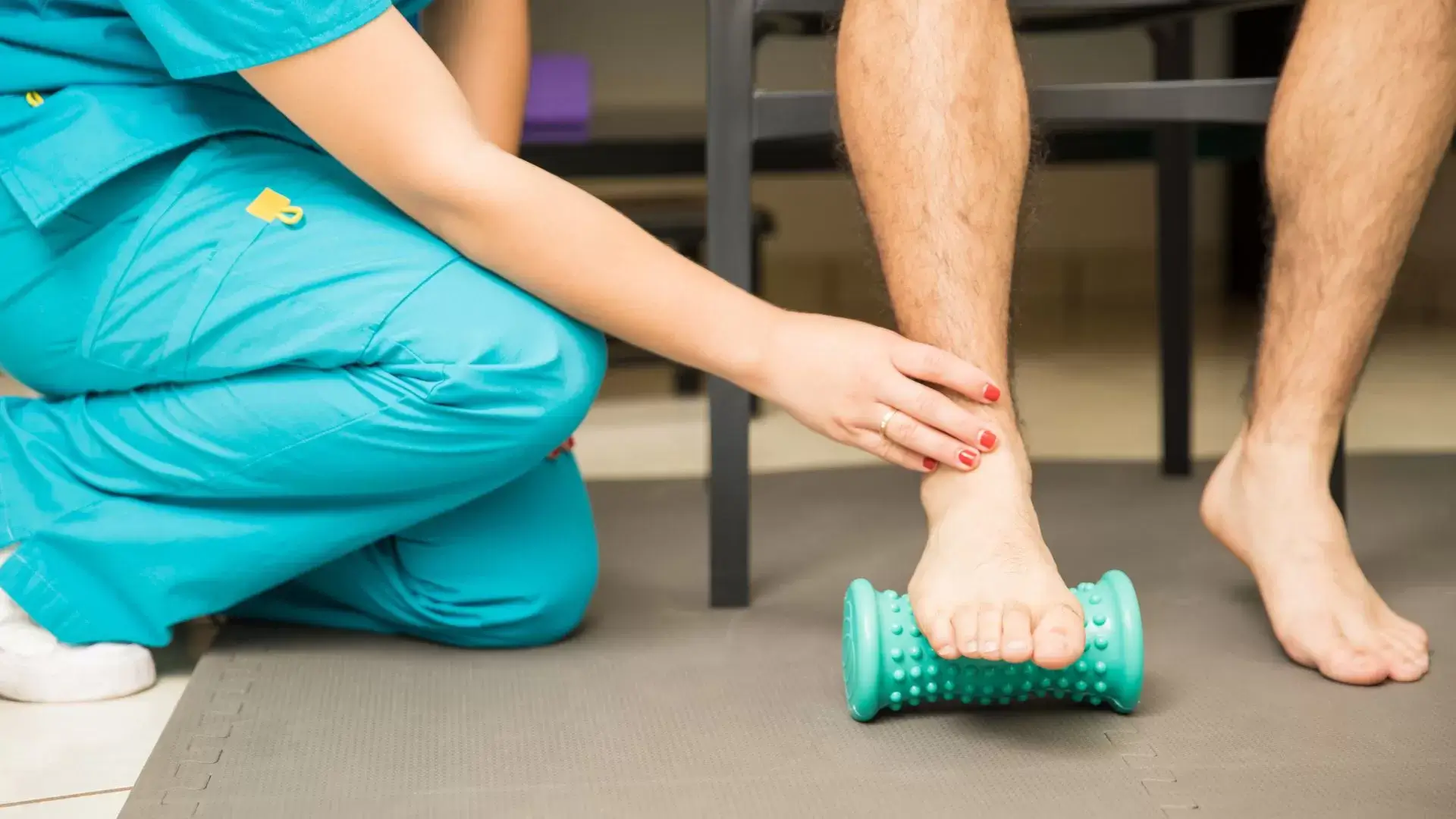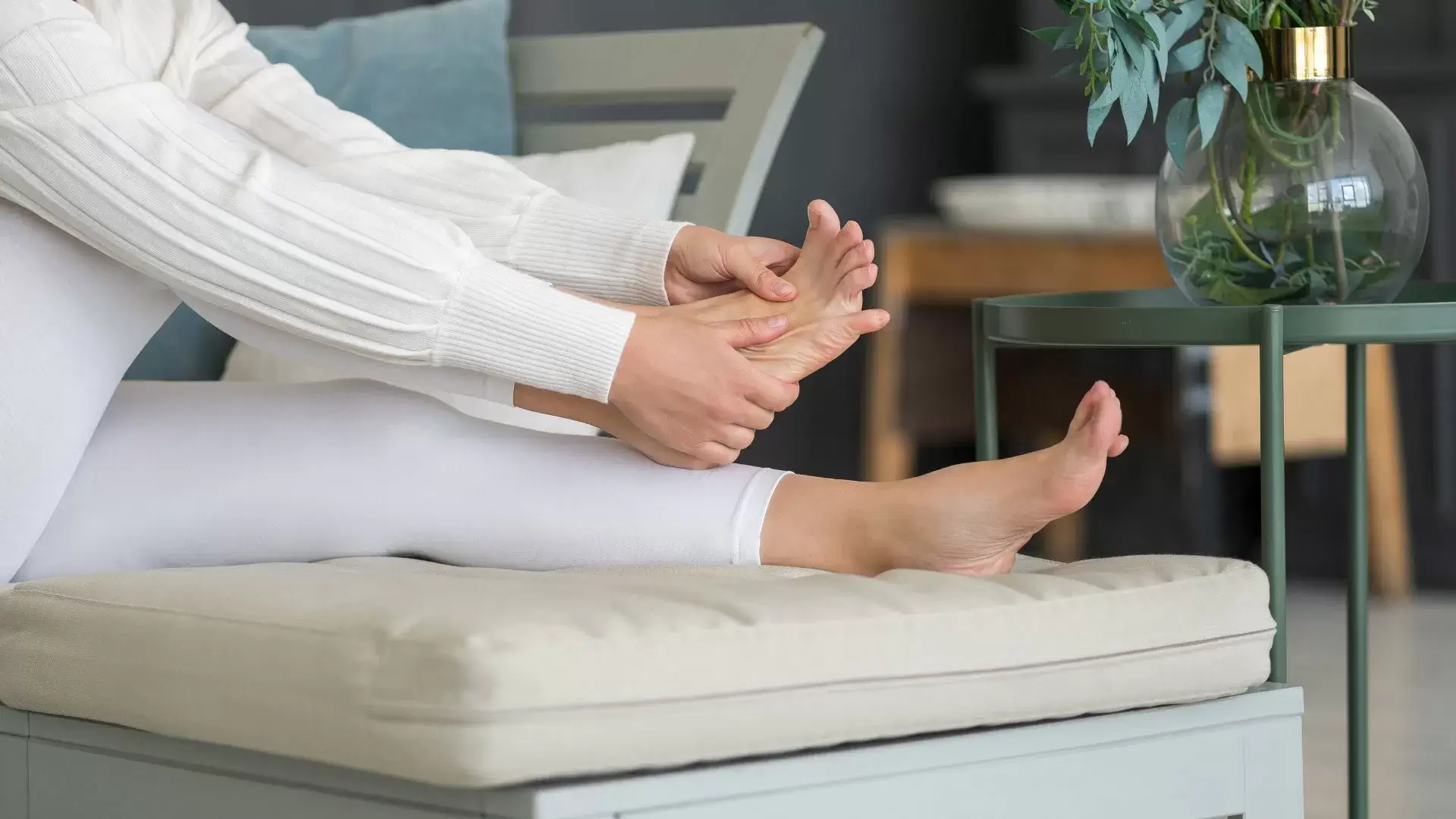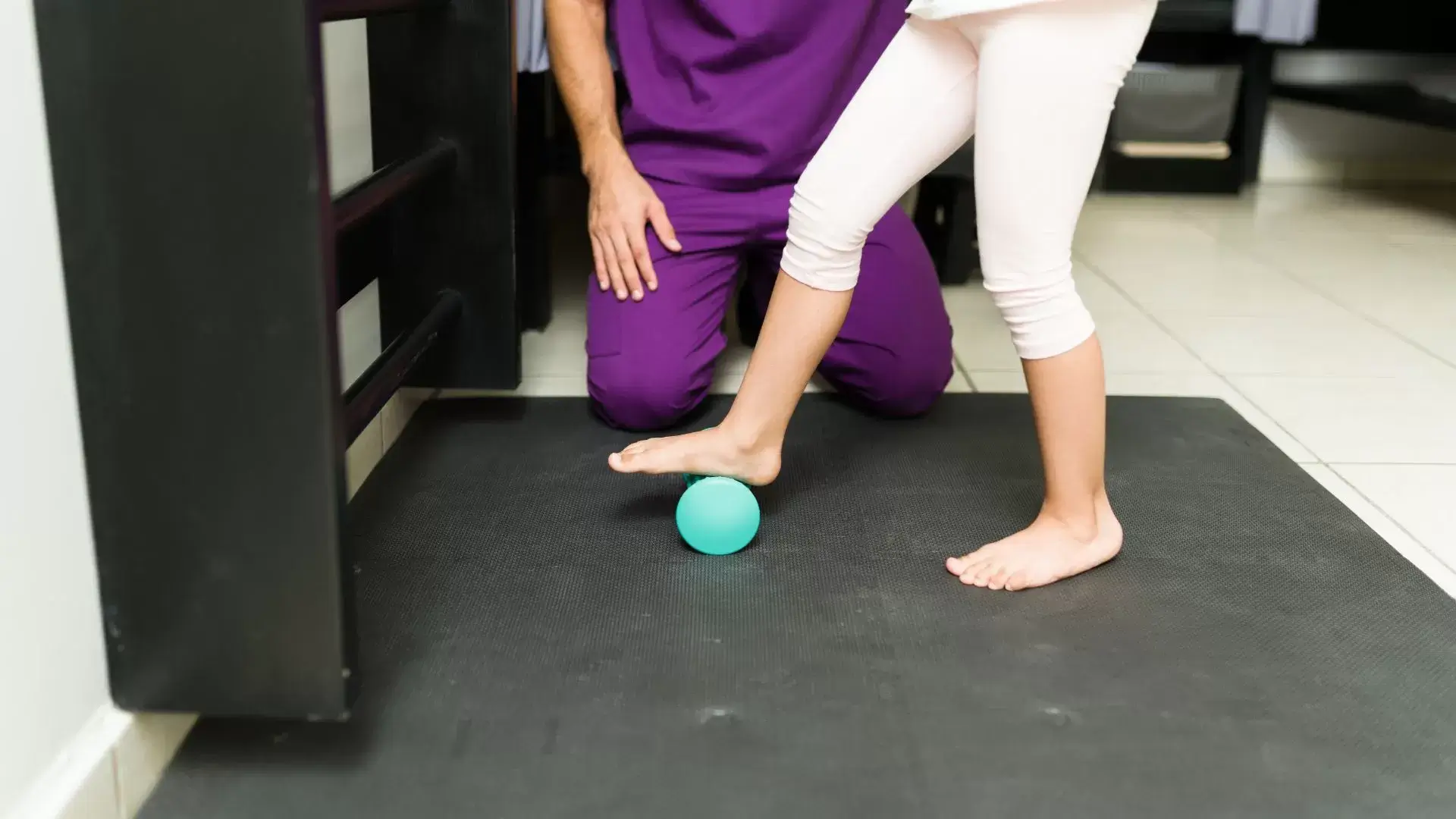At our Best Physiotherapy & Chiropractic Clinic in Mississauga, we focus on effective physiotherapy for plantar fasciitis. Our team uses personalized treatment plans that include targeted exercises, advanced techniques, and thorough assessments to reduce pain and enhance mobility. We recognize how debilitating plantar fasciitis can be, particularly affecting daily activities with heel and arch pain. Our goal is to help you regain function and improve your quality of life through tailored strategies, including gait analysis and orthotics. Together, we can work towards long-term relief and recovery, ensuring you feel informed about each step in your journey. More insights are just ahead!

At Mississauga Physio Chiro Clinic , we combine expert physiotherapy and chiropractic services to effectively address the pain and discomfort associated with plantar fasciitis. Our team of skilled professionals, including foot and ankle specialists and foot orthotics specialists, provides extensive plantar fasciitis treatment tailored to each patient’s unique needs.
We understand that foot pain and heel pain can greatly impact daily activities. That’s why we focus on an accurate plantar fasciitis diagnosis to determine the best course of action. Our physical therapy programs include targeted plantar fasciitis exercises designed to strengthen the foot and improve flexibility, helping alleviate discomfort and promote healing.
In addition to these exercises, we offer personalized foot therapy sessions aimed at reducing inflammation and pain. Our physiotherapy and chiropractic services work hand-in-hand to guarantee that we address not just the symptoms but also the underlying causes of your condition. By utilizing advanced techniques and equipment, we provide effective interventions that can lead to long-term relief from plantar fasciitis.
Together, we can help you regain mobility and return to the activities you love, free from the burden of foot pain. Your journey to recovery begins with us.
Understanding how plantar fasciitis impacts foot health and daily life is essential for effectively managing this common condition. Many of us experience foot discomfort, particularly in the form of arch pain or heel tenderness. These symptoms often stem from foot inflammation caused by excessive heel pressure during daily activities. Over time, this can lead to significant walking pain, making it difficult to perform even simple tasks.
Our foot biomechanics play a significant role in how we experience plantar fasciitis symptoms. When our feet aren’t properly aligned or supported, it can exacerbate the discomfort we feel. This not only affects our mobility but can also hinder our ability to engage in physical activities we enjoy, which can lead to frustration and decreased quality of life.
To combat these issues, rest and recovery are essential. Allowing our feet to heal and incorporating physiotherapy can help alleviate pain and restore function. By understanding the effects of plantar fasciitis on our daily lives, we can take proactive steps towards improving our foot health, ultimately leading to a more active and fulfilling lifestyle.
Several factors contribute to the development of plantar fasciitis and persistent foot pain, including improper footwear, excessive physical activity, and certain anatomical issues. One of the most common plantar fasciitis causes is overpronation, where the foot rolls inward excessively during walking or running. This can lead to foot strain and chronic heel pain. Individuals with flat feet or high arches are also at risk, as these anatomical variations can affect the distribution of weight and increase stress on the plantar fascia.
Moreover, engaging in high-impact exercises without adequate foot arch support can result in foot injuries. It’s important to be mindful of our activities, as excessive physical activity can exacerbate heel swelling and lead to persistent weight-bearing pain. Additionally, those with jobs that require prolonged standing may experience similar discomfort.
When we experience heel and arch pain, it often points to plantar fasciitis, characterized by sharp, stabbing sensations, especially during the first steps in the morning or after prolonged periods of sitting. This acute heel pain can be accompanied by discomfort in the foot sole, making daily activities challenging. Many of us may notice that morning foot pain gradually eases as we move throughout the day, but it can return after long periods of inactivity.
The condition is primarily linked to inflammation of the plantar fascia, the thick band of tissue that runs along the bottom of our feet. In some cases, a heel spur may develop, contributing to chronic foot inflammation and exacerbating our symptoms. To find plantar fasciitis relief, we might consider incorporating foot stretching and foot massage into our routine. These practices can aid in inflammation reduction and improve flexibility.
Recognizing these symptoms early can help us address the issue before it becomes more severe. If we remain aware of the signs and manage our discomfort proactively, we can enhance our quality of life and prevent further complications related to plantar fasciitis.

To manage the discomfort caused by plantar fasciitis, we can explore various physiotherapy solutions that target both pain relief and long-term recovery. One effective strategy is conducting a thorough gait analysis, which helps us identify abnormal movement patterns contributing to foot pain. By understanding these patterns, we can implement tailored foot strengthening exercises designed to improve foot mobility and support.
Incorporating night splints into our routine can also provide significant plantar fasciitis relief by ensuring the plantar fascia remains in a stretched position overnight. Additionally, we can utilize ice therapy post-activity to reduce inflammation and alleviate discomfort effectively. For those with persistent pain, corticosteroid injections may be considered as a temporary measure to reduce inflammation.
Moreover, we should not underestimate the importance of supportive footwear and custom orthotics, which can provide the necessary arch support and cushioning needed for daily activities. By combining these physiotherapy solutions, we can create a thorough approach that not only addresses immediate pain but also promotes long-term recovery, enabling us to return to our normal activities with confidence and comfort.
Hands-on therapy, covering soft tissue and manual techniques, can greatly enhance our approach to alleviating foot pain associated with plantar fasciitis. By utilizing these methods, we can effectively target the tightness in the foot ligaments and surrounding tissues. This not only aids in pain management but also promotes overall rehabilitation.
Soft tissue techniques, such as deep tissue massage and myofascial release, help to reduce muscle tension and improve circulation. These approaches can alleviate discomfort in the heel and arch, making daily activities more manageable. Additionally, manual techniques, including joint mobilization, can improve foot mechanics and enhance mobility.
Incorporating calf stretching into our routine is also essential, as tight calf muscles can exacerbate plantar fasciitis symptoms. We should consider consulting a podiatrist for personalized shoe inserts, which can provide the necessary support and cushioning. Together, these strategies create an all-encompassing pain management plan aimed at enhancing recovery.
Building foot strength is essential for supporting the plantar fascia and preventing further injury, as it allows us to enhance stability and improve overall foot function. Through targeted exercises, we can effectively address issues such as plantar fascia inflammation and exercise-induced foot pain. Strengthening the muscles in our feet helps distribute foot pressure points more evenly, reducing the risk of repetitive strain injuries.
One effective approach in our plantar fasciitis rehabilitation involves incorporating exercises that focus on building foot strength. Simple activities like toe curls and towel scrunches can greatly improve our foot strength, while also providing heel cushioning. Additionally, we should consider balancing exercises to enhance our stability, which can help alleviate foot stress and prevent conditions such as Achilles tendonitis.
Incorporating essential stretching techniques into our routine can greatly enhance foot flexibility and aid in the recovery from plantar fasciitis. By focusing on the fascia tissue and surrounding muscles, we can considerably alleviate standing pain and reduce the risk of sports injuries, particularly for runners experiencing running-related foot pain.
One effective method involves calf stretches, as tight calf muscles can exacerbate plantar fasciitis. Standing with one foot behind the other, we can press our heel into the ground while bending the front knee. This stretch targets both the calves and the plantar fascia, promoting better foot flexibility.
Another technique is the toe stretch, where we can sit and pull our toes towards us while keeping our heel on the ground. This helps lengthen the fascia tissue and improve overall foot mobility.
Using heel cups can also provide additional support during our stretching routine, further aiding in plantar fasciitis prevention. Additionally, plantar fasciitis taping techniques can offer stability and remind us to maintain proper foot alignment during our stretches. By consistently integrating these essential stretching techniques, we’ll promote healing and enhance our overall foot health.

While stretching techniques play a vital role in managing plantar fasciitis, advanced therapies like shockwave and ultrasound offer innovative solutions for those seeking additional relief from foot pain. In our practice, we often recommend shockwave therapy for patients experiencing chronic foot nerve pain or a plantar fascia tear. This non-invasive treatment uses high-energy sound waves to stimulate healing and reduce inflammation, promoting faster recovery from running injuries.
On the other hand, ultrasound therapy utilizes sound waves to penetrate deep tissue, enhancing blood flow and reducing swelling. This can be particularly beneficial for patients in Mississauga, Ontario, who are struggling with persistent symptoms of plantar fasciitis. Both therapies can complement traditional physiotherapy approaches, offering an extensive treatment plan tailored to each patient’s unique needs.
Additionally, combining these advanced therapies with PRP therapy may further accelerate healing for those with severe conditions. By integrating shockwave and ultrasound therapy into our treatment modalities, we can help our patients regain mobility and return to their active lifestyles more efficiently. Ultimately, these advanced therapies serve as a beacon of hope for anyone battling the discomfort of plantar fasciitis.
Proper footwear, along with orthotics and shoe inserts, plays an essential role in our recovery from plantar fasciitis by providing crucial support and alignment to the foot’s structure. When we wear shoes designed with arch support and cushioning, we can alleviate the strain on our plantar fascia and achilles tendon, which can greatly speed up our recovery process.
At our clinic located at 123 abc road, we often recommend custom orthotics tailored to our specific foot shape and walking habits. These inserts help distribute pressure evenly across our feet, reducing pain and discomfort. It’s important to remember that while some might consider barefoot walking a natural choice, it often exacerbates plantar fasciitis symptoms due to lack of support.
In addition to orthotics, proper footwear can complement treatments like laser therapy, helping to reduce inflammation and promote healing. For those who are struggling with persistent pain, discussing options like plantar fasciitis surgery may be necessary. If you have any questions or need assistance, don’t hesitate to contact us. Together, we can find the right solutions to enhance our recovery journey.
Reducing inflammation is essential for our recovery from plantar fasciitis, and techniques like ice therapy, taping, and night splints can greatly aid in alleviating pain and promoting healing. Ice therapy is one of the simplest yet most effective methods we can use. Applying ice to the affected area for 15-20 minutes several times a day helps decrease swelling and numbs the pain.
Taping is another valuable technique. By using specific taping methods, we can provide support to the arch and heel, reducing strain on the plantar fascia. This support not only helps in relieving pain but also aids in keeping our foot in a more ideal position during activities.
Night splints are particularly beneficial, as they gently stretch the plantar fascia and Achilles tendon while we sleep. By maintaining a stretched position overnight, we can reduce morning stiffness and improve overall flexibility in the foot.
Incorporating these strategies into our treatment plan can considerably enhance our recovery journey. We should consult a physiotherapist to guarantee we’re using these techniques correctly for the best results. Together, we can work towards minimizing inflammation and getting back to our daily activities pain-free.
Understanding how our gait and biomechanics contribute to chronic heel pain can greatly enhance our recovery efforts beyond just reducing inflammation. By conducting a thorough gait analysis, we can identify specific patterns that may be exacerbating our symptoms. This analysis often reveals compensatory movements or imbalances that place undue stress on the plantar fascia, leading to increased pain and discomfort.
Once we’ve pinpointed these issues, we can implement biomechanical adjustments tailored to our unique needs. These adjustments might include modifying our footwear, using orthotics, or incorporating specific exercises aimed at improving strength and flexibility. By addressing the underlying biomechanical factors, we not only alleviate pain but also promote more efficient movement patterns.
We should also consider the importance of education in this process. By understanding how our body mechanics function, we empower ourselves to make informed choices about our activities and physical health. Collaborating with our physiotherapist throughout this journey can guarantee we stay on track, helping us achieve long-lasting relief from chronic heel pain. Together, we can work towards restoring peak function and enhancing our overall well-being.
Making simple lifestyle modifications can greatly reduce the chances of plantar fasciitis returning and help us maintain ideal foot health. First, we should focus on our footwear. Wearing shoes with proper arch support and cushioning is essential, as it helps distribute body weight evenly and minimizes stress on our feet. Avoiding high heels and flip-flops can also make a notable difference.
Next, we need to incorporate regular stretching and strengthening exercises into our routine. Focusing on the calf muscles, Achilles tendon, and the plantar fascia itself can enhance flexibility and strength, reducing the likelihood of re-injury. Additionally, maintaining a healthy weight is vital; excess weight increases pressure on our feet, exacerbating any underlying issues.
We should also pay attention to our activity levels. Gradually increasing our physical activity, especially if we’re returning to exercise after a break, helps avoid overloading our feet. Finally, taking breaks during prolonged standing or walking can give our feet the rest they need. By making these lifestyle changes, we can considerably lower the risk of plantar fasciitis returning and enjoy a more active, pain-free life.
When faced with plantar fasciitis, we have a range of treatment options available, both non-surgical and surgical, to help alleviate pain and restore function. Non-surgical treatments often come first, as they’re less invasive and can yield significant results. These may include physical therapy, which focuses on stretching and strengthening exercises, the use of orthotic devices, and modalities like ultrasound or ice therapy. We might also consider cortisone injections to reduce inflammation.
If non-surgical methods don’t provide relief after several months, surgical options may be explored. Surgical interventions can vary from releasing the plantar fascia to addressing any underlying structural issues in the foot. It’s crucial to recognize that surgery is typically seen as a last resort, as it involves recovery time and potential complications.
Ultimately, the choice between non-surgical and surgical treatments depends on the severity of our condition, our lifestyle, and how we respond to initial therapies. Consulting with a healthcare professional can help us make an informed decision tailored to our individual needs, ensuring we choose the best path towards recovery and improved foot health.
Rehabilitation and long-term strategies are vital for maintaining foot health and preventing the recurrence of plantar fasciitis. After completing our initial treatment, we should focus on incorporating specific exercises and lifestyle changes that promote overall foot wellness. Stretching our calves and the plantar fascia can greatly enhance flexibility, while strengthening exercises targeting the foot’s intrinsic muscles help support the arch.
We also need to pay attention to our footwear. Choosing shoes that provide adequate arch support and cushioning can make a world of difference. It’s beneficial to avoid walking barefoot on hard surfaces, as this can strain our feet. Additionally, we should consider using orthotic inserts if recommended by a healthcare professional.
Regularly evaluating our activity levels is essential, too. Gradually increasing our physical activity can help our feet adapt without overloading them. Incorporating rest days into our routine allows for recovery and helps prevent overuse injuries.
How can we guarantee lasting relief from plantar fasciitis? By seeking professional physiotherapy care in Mississauga, we can receive tailored treatments that address our specific needs and promote ideal recovery. A skilled physiotherapist will evaluate our condition, considering factors such as pain levels, foot mechanics, and overall lifestyle. This thorough assessment allows them to develop a personalized treatment plan that may include manual therapy, strengthening exercises, and stretching routines.
Moreover, physiotherapy isn’t just about addressing symptoms; it’s about understanding the root causes of our discomfort. By incorporating education on proper footwear, activity modifications, and self-care strategies, we empower ourselves to manage our condition effectively. Regular sessions with a physiotherapist can guarantee we stay on track, making adjustments to our treatment as we progress.
In Mississauga, we have access to experienced professionals who are dedicated to helping us regain mobility and reduce pain. By committing to this process, we not only find relief but also build a solid foundation for long-term foot health. Let’s take this step together and prioritize our well-being by seeking the expert care we deserve.
Mississauga, a vibrant and diverse city in Ontario, offers a wealth of resources and amenities that contribute to a healthy and active lifestyle. With its extensive network of parks, recreational facilities, and community programs, we’re well-equipped to support our residents in their wellness journeys. The city boasts numerous walking and biking trails, encouraging outdoor activity that can be particularly beneficial for those managing conditions like plantar fasciitis.
We also have a variety of health services available, including physiotherapy clinics specializing in sports injuries and musculoskeletal disorders. These clinics not only provide treatment but also offer education on injury prevention and management, ensuring that we’re informed and empowered to maintain our health.
Cultural diversity enriches our community, fostering an inclusive environment where everyone can feel supported. Local events and programs promote physical activity and community engagement, motivating us to stay active together.
In Mississauga, we pride ourselves on our commitment to health and well-being, making it easier for us to seek the care and resources we need, including effective physiotherapy for plantar fasciitis. Together, we can endeavor for a healthier, more active lifestyle.

When we consider recovery from plantar fasciitis through physiotherapy, it typically takes about 6 to 12 weeks. However, it really depends on several factors, including the severity of the condition and our individual response to treatment. We’ll often see improvements within a few sessions, but full recovery might require consistent therapy and exercises at home. It’s crucial to stay committed and follow our physiotherapist’s recommendations for the best outcomes.
When dealing with plantar fasciitis, we can often continue exercising, but it’s essential to modify our routines. Low-impact activities like swimming or cycling might be suitable while avoiding high-impact exercises that exacerbate our symptoms. We should listen to our bodies and consult with our healthcare provider to guarantee we’re making safe choices. By staying active within our limits, we can aid our recovery and maintain our overall fitness during treatment.
During our first physiotherapy appointment, we can expect a thorough assessment of our condition. The therapist will discuss our medical history and any symptoms we’ve been experiencing. They’ll likely conduct some physical tests to evaluate our movement and pain levels. Based on their findings, they’ll create a personalized treatment plan. We should feel encouraged to ask questions, share concerns, and learn about the techniques that’ll help us in our recovery journey.
When it comes to finding relief from plantar fasciitis, there are several home remedies we can try. Stretching exercises for the calves and feet can help alleviate tension. Ice packs applied to the affected area can reduce inflammation. We might also consider using supportive footwear or orthotics to provide better arch support. Additionally, rolling a frozen water bottle under our feet can offer soothing relief. It’s important to listen to our bodies and adjust accordingly.
Plantar fasciitis can indeed be more common in certain age groups. We often see it affecting individuals between 40 and 60 years old, likely due to the wear and tear on the feet over time. However, it can also impact younger, active individuals, especially those who engage in high-impact sports. Understanding these trends helps us recognize risk factors and encourage preventative measures for all age groups to maintain foot health.
Reach out to us today to book an appointment or learn more about our services. Our friendly team is here to answer your questions and help you take the first step toward improved health and wellness.
(647) 372-1209

At our “Mississauga Physio Chiro Clinic”, we are dedicated to providing personalized care that addresses the root cause of your discomfort. With a team of experienced physiotherapists and chiropractors, we focus on restoring your mobility, relieving pain, and enhancing your overall well-being.